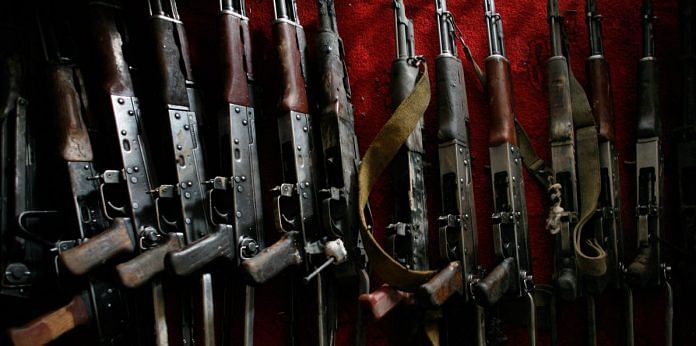A new study by US scholars talks about how ‘armed gangs’ pursue a ‘diverse array of electoral strategies’ to participate in elections.
Democracies in Pakistan, India and Sri Lanka have at various times witnessed a complex concoction of ‘bullets and ballots’. But by and large, political scientists have focused on how political parties in these democracies manipulate armed gangs and the eruption of violence during elections. But not too many explore the agency of the ‘armed actors’ themselves.
A new study, How and Why Armed Groups Participate in Elections, published by Cambridge Core delves into how armed gangs pursue a ‘diverse array of electoral strategies’. The paper, written by Aila M. Matanock (assistant professor of political science at the University of California-Berkeley) and Paul Staniland (associate professor of political science at the University of Chicago), defines ‘armed actors’ broadly as non-governmental entities using extra-legal violence to achieve political aims related to the state or its governance.
Also read: Pakistan Army’s decades-long war on political parties continues
The paper identifies several distinct strategies of electoral participation by armed groups – directness, i.e. whether or not armed groups run their own candidates in elections; openness, i.e. whether or not armed groups make public, official statements expressing electoral positions; openly fusing bullets and ballots to form an armed political party; covertly controlling a political wing that puts up candidates in elections; overtly targeting particular parties or politicians; and secretly providing resources to distinct political parties.
“Groups that expect to do relatively well in elections and see opportunities to shift policy in their direction by doing so pursue direct participation,” says the study. However, if governments show little tolerance for this and move to block them, then the groups move to build formal party structures to escape the ban.
“Groups that do not expect to do well in elections, by contrast, tend to pursue indirect methods of involvement, by backing or targeting specific parties, politicians, and even voters that they do not control,” the study says.
Strategies employed
What about groups that follow radical ideologies and aim to discredit the entire political system?
They go for ‘non-participation’ and ignore or target all electoral actors as part of their campaign against the state, to broadly delegitimise the political system. “Such targeting can be hugely consequential, but has a different significance than efforts to ‘game’ electoral politics,” say the authors.
It’s when the armed groups start to influence political outcomes during elections that things get murky. According to the paper, armed groups can participate in elections either covertly or overtly. “Most groups choose to seek to influence elections’ outcome through some type of participation,” it says.
An approach that has been underestimated by scholars so far is that many armed groups with less radical goals see “opportunities for both conflict and cooperation with mainstream electoral actors.”
The paper identifies four strategies – Overt Direct, Covert Direct, Overt Indirect, and Covert Indirect.
Covert direct strategies are used when an armed group controls a political party without publicly admitting the link. They claim that they are separate from the political wing, “intentionally cultivating ambiguity and misinformation about the connection.”
Some examples include: left-wing Irish PIRA and Sinn Fein, the Basque terrorist group Basque Homeland and Liberty (ETA) and political parties, including Batasuna in Spain, the Sipah-e-Sahaba Pakistan (SSP) and its armed wing, the Lashkar-e-Jhangvi in Pakistan.
Also read: Is democracy voting itself out in elections?
Overt indirect strategies are quite common and involve directly attacking a party and its supporters. For example, attack on National Conference (NC) cadres by Kashmiri militants, and the JVP insurgency in Sri Lanka.
Covert indirect strategies are used when armed groups secretly attack or support mainstream parties and candidates. For example, the Tamil Tigers (LTTE) tacitly supported candidates linked to the Eelam Revolutionary Organisation of Students (EROS) in 1989 and tolerated the Tamil National Alliance (TNA) in the 2001.
Pakistan, too, has seen overt direct participation. The roots of Muttahida Qaumi Movement, the party which earlier asked Imran Khan to claim to country back from occupation, lie in the All-Pakistan Mohajir Students Organization (APMSO), which was formed in the violent campus politics of the late 1970s. The armed APMSO pursued the electoral path through MQM from 1987 onwards during the dictatorship of Zia-ul-Haq as a way to carve out influence against its local rivals.
Pakistan has also seen overt, indirect participation in elections in the past where “participation, by contrast, tends to be aimed at undermining parties that are seen as serious political threats to the armed group’s interest.”
Tehrik-i-Taliban Pakistan (TTP)’s actions in 2013 Pakistan general election is a classic example of this strategy. The TTP was a radical, anti-system party. It was ideologically opposed to elections to begin with, and would not have been allowed to run as an armed political party. However, TTP vigorously opposed the Awami National Party, the MQM and the Pakistan Peoples Party since they represented an ideological obstacle to its Islamising agenda. The TTP publicly warned against attending these parties’ rallies and aggressively targeted them. “This was a violent campaign trying to tip the electoral balance against particularly dangerous parties, without necessarily actively supporting its mainstream rivals,” adds the paper.
Even groups that are ideologically opposed to democracy understand the stakes in order to get involved.
Also read: Shalwar qameez and Kaptaan chappals: How Imran Khan is wearing his politics on his sleeves
However, these participation strategies are subject to modification with change in the approach of armed groups in electoral politics over time. Matanock and Staniland say it is important for political scientists to research the ‘porous’ boundaries between ‘normal’ and ‘armed’ politics.
You can read the full report by Aila M. Matanock and Paul Staniland here. The study was published in the American Political Science Association journal.






